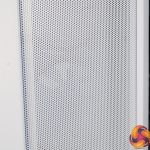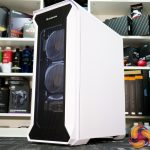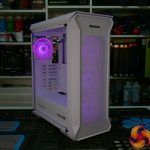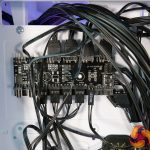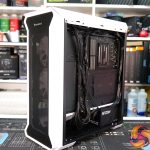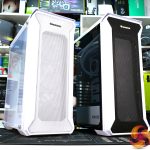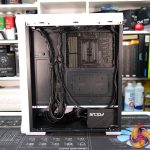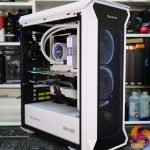Genesis launched its IRID 505 chassis in 2020 with two versions of the case originally made available in black. The IRID 505 ARGB had all the bling while the standard IRID 505 was a cheaper and more subtle offering aimed at the non-RGB ‘purists'. Genesis has recently launched revised versions of the IRID 505 and 505 ARGB featuring all white and two-tone colour schemes though, so which one would you choose?
Timestamps:
Because these cases technically launched almost two years ago (in black), we figured that you guys will have already seen the reviews of the Genesis IRID 505 chassis series. So instead of an in-depth technical review with a detailed cooling analysis of the IRID 505, we picked our preferred version of the revised cases and set to work on building a system, to see what the IRID 505 is like to use for a build in the real world.
Before we dive into the build though, let’s take a quick look at the specifications. The new Genesis IRID 505 is almost an exact replica of the original in terms of the chassis structure, features and specifications. It supports up to ATX motherboards, including Micro-ATX and Mini-ITX, as well as graphics cards up to 380mm long and CPU coolers up to 165mm tall, so normal for a basic mid-tower chassis.
The difference between the two new versions is easy to see. The IRID 505 ARGB has a completely white colour scheme and arrives with four 120mm ARGB fans and an ARGB fan hub that deals with lighting control and PWM, while the standard IRID 505 (Non-ARGB version) has a two-tone white and black design with just two plain white 120mm fans pre-installed. The fans run up to 1200 RPM so should provide quiet operation.
Up to seven 2.5-inch SSDs can be installed in the IRID 505, three can be mounted directly to the motherboard tray, two on a removable SSD bracket screwed to the back of the motherboard tray and two more inside the 2.5/3.5-inch HDD caddy located beneath the PSU shroud. Alternately two 3.5 HDDs can be installed in the tool-free HDD caddy, or the caddy can be removed completely to make space for front-mounted radiators or PSU cables.
The chassis should also offer ample space for cooling. According to the official specs up to 280mm radiators can be installed in the front or roof of the case. Three 120mm or two 140mm fans can be fitted up front and up to two 120mm/140mm fans can be installed in the roof. A single 120mm fan or radiator can be installed in the rear.
Genesis IRID 505 (ARGB) Specification:
- Motherboard form factor: ATX, Micro-ATX, Mini-ITX
- Front I/O panel: Mini Jack x2, USB Type-A 2.0 x2, USB Type-A 3.0 x2
- Fan support: rear 1x 120mm, front 3x 120mm/3x 140mm, top2x120mm/2x 140mm
- Radiator Support: rear 120mm, front 120mm/240mm/280mm,top 240mm/280mm
- Type of front panel: Mesh
- Type of side panel: Tempered glass
- Installed fans: 4x 120mm ARGB (IRID 505 ARGB)
- Maximum number of 3.5″ bays: 2
- Maximum number of 2.5″ bays: 7
- Maximum GPU length: 80 mm
- Maximum CPU cooler height: 165 mm
- Maximum PSU Length: 190 mm
- Dust filters: Front, Top, Floor
- Weight: 6.95 kg
- Dimensions (L x W x H): 447mm x 220mm x 510mm
IRID 505 Build Process:
Before starting the build we wanted to investigate Genesis claim of only being able to install up to a 280mm radiator in the front of the case, we thought since the case allows for three 120mm fans to be installed in the front panel, a 360mm radiator should fit there too. We grabbed a 360mm Asetek based AIO and sure enough, it seems to fit perfectly so Genesis either made a mistake with the official spec or just simply overlooked this feature.
Since we chose to use the standard non-ARGB version of the IRID 505 for the build, we selected hardware to match the two-tone black and white theme. Aesthetically the build turned out looking great. However, the case ended up being one the most irritating to work with if you want to install a 280mm AIO cooler. It seems to us that it is impossible to fit a 280mm Asetek AIO radiator in the roof of the case with the tubes either at the front or rear as it fouls on the front I/O mounts and EPS cables.
Build Specification:
- Case – Genesis IRID 505
- CPU – AMD Ryzen 7 5800X
- Motherboard – NZXT N7 B550
- Memory – 32GB Corsair Vengeance RGB Pro DDR4 3600MHz (4 x 8GB)
- Graphics Card – Sapphire AMD Radeon RX 6800 Nitro+
- 1st M.2 SSD Drive – 2TB WD Black SN850 PCIe Gen4 M.2 NVME SSD
- Power Supply – Seasonic Focus PX-850 850W 80+ Platinum
- CPU cooler – NZXT Kraken X63 RGB (280mm)
- Extra Case Fans – 3 x 120mm be Quiet! Silent Wings 3 High Speed
- Operating System – Windows 10 Professional
Fitting a 280mm AIO radiator in the front is a compromise too. It again seems to be impossible to install a 280mm Asetek AIO with the fans on the back of the radiator in a pull configuration as the radiator fouls the I/O mount again. With the fans in front of the radiator in a push configuration, the AIO fits but it is extremely tight to the motherboard tray. The fact that there are no fan cable cutouts at the front of the case also means that cables are squashed between the radiator and motherboard tray.
So, with this in mind, we think it would be best to stick to 240mm AIO radiators in the IRID 505, or fitting a 360mm AIO in the front should be possible as we found out earlier. Either will be easier than fitting a 280mm AIO for sure. But other than this AIO issue, the build process went well, there is plenty of space around the motherboard to work and long graphics cards such as the Sapphire Radeon RX 6800 Nitro+ that we used fit with a front-mounted AIO installed.
The Genesis IRID 505 seem to be a basic budget/mid-range chassis that’s well built, it supports typical hardware for standard desktop or gaming builds and has the potential for good airflow with the mesh front. However, there is fierce competition in the sector of the market so it might have a difficult time when put up against the likes of the Fractal Meshify C, Phanteks P400 series and the Corsair 4000D.
KitGuru says: What do you guys think of the IRID 505 series from Genesis? Would you choose it over competitors cases in the same price range? if so, would it be the standard IRID 505 or the ARGB version for you? Let us know!
 KitGuru KitGuru.net – Tech News | Hardware News | Hardware Reviews | IOS | Mobile | Gaming | Graphics Cards
KitGuru KitGuru.net – Tech News | Hardware News | Hardware Reviews | IOS | Mobile | Gaming | Graphics Cards



